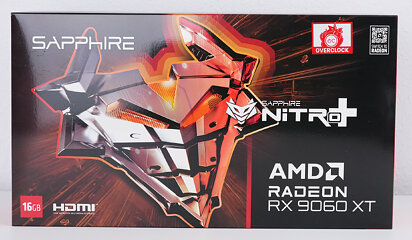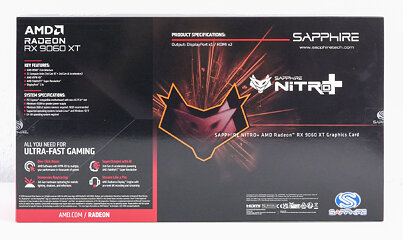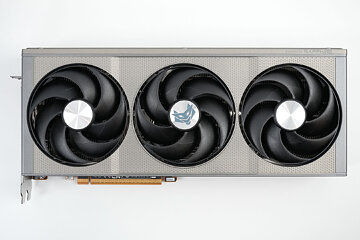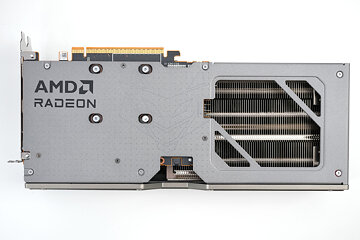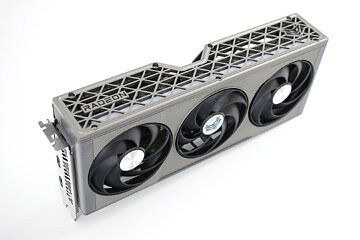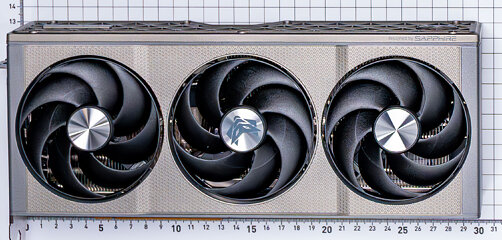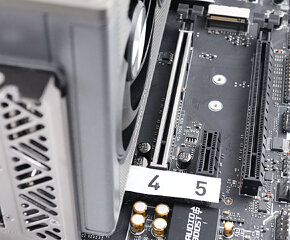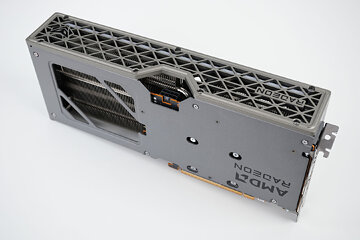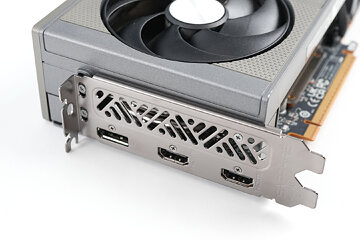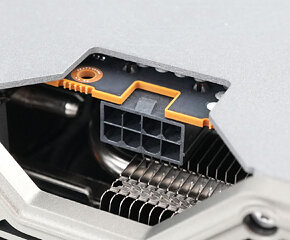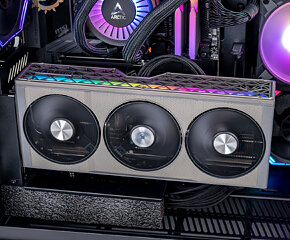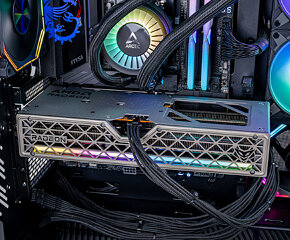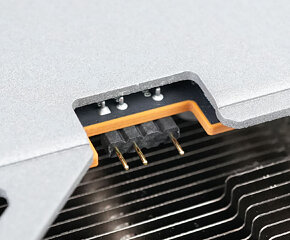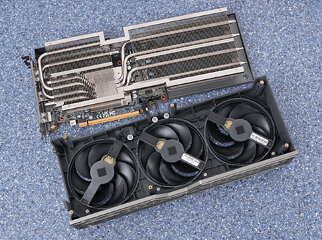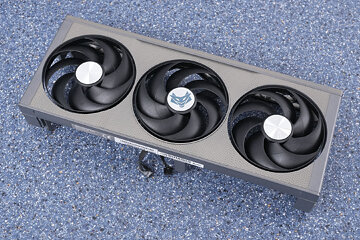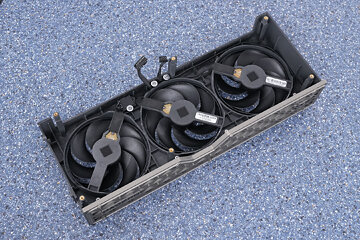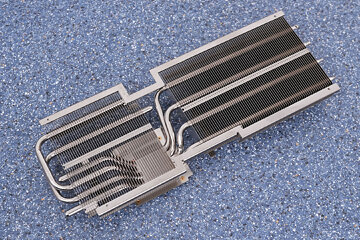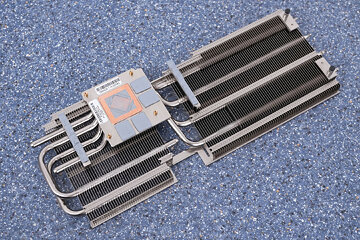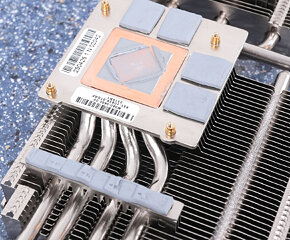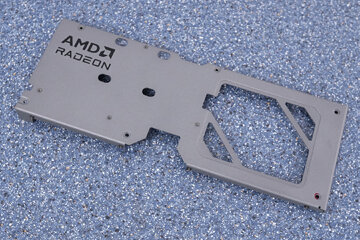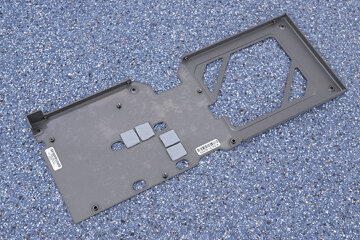 35
35
Sapphire Radeon RX 9060 XT Nitro+ OC Review - The Fastest RX 9060 XT
Circuit Board Analysis »Packaging
The Card
Sapphire introduced a new design theme for the Nitro series of this generation. The main color is gray, but there are several highlights. The metal backplate has a large cutout for air to flow through.
Dimensions of the card are 30.5 x 13.5 cm, and it weighs 989 g.
Installation requires three slots in your system. We measured the card's width to be 50 mm.
Display connectivity includes one standard DisplayPort 2.1b and two HDMI 2.1b.
AMD put in some extra work for creative professionals, particularly those into video editing, by giving Navi 44 its latest video engine. The video engine supports concurrent hardware-accelerated encode and decode for AV1, HEVC, and H.264 video codecs. With RDNA 4, AMD has improved the image quality of H.264 encoding at lower bitrates, which should make AMD appeal to content creators. The AV1 encoder and decoder support B-frames, a technology with which there can be a significant reduction in bitrates without a loss in image quality. While the RX 9070 Series has a dual encoder setup, the GPU of the RX 9060 XT comes with just a single encoder.
The card uses a single 8-pin connector, which allows a maximum power draw of 150 W, plus 75 W from the slot, but the actual board power limit is set much lower of course.
Sapphire has installed an RGB lighting zone along the top edge of the card.
This connector is used to synchronize the lighting of your system with the graphics card.
Teardown
The fan assembly can be removed easily, which makes it easy to replace a broken fan in a couple of years—no need to touch the thermal paste of the card.
Sapphire has installed four heatpipes on their thermal solution, the main heatsink also provides cooling for the memory chips and VRM circuitry.
The backplate protects the card against damage during installation and handling. Note the thermal pads, which provide cooling for the memory chips on the back-side of the PCB.
Jul 24th, 2025 16:13 CDT
change timezone
Latest GPU Drivers
New Forum Posts
- Corsair RM850x (2021) 12V Rail Dropping — Causing Crashes While Gaming (3)
- [USA] [Newegg] PCCOOLER CPS RZ620 Dual Tower CPU Air Cooler $23 (regular $70) same cooler I own currently (it even beats 360 AIO water coolers) (8)
- Lexar NM790 (4TB) made my PC go back to Windows XP days, since it caused my PC to be SO slow and laggy! (21)
- Which Linux flavor? (54)
- AI Job Losses: let's count the losses up, total losses to AI so far 94,000 and counting (60)
- RX 9000 series GPU Owners Club (1193)
- Share your CPUZ Benchmarks! (2533)
- What are these keycaps? (1)
- Need some help finding correct VBIOS for my RX580 (8)
- What's your latest tech purchase? (24356)
Popular Reviews
- Noctua NF-A12x25 G2 PWM Fan Review
- MSI MPG B850I Edge Ti Wi-Fi Review
- Cougar OmnyX Review
- Thermal Grizzly WireView Pro Review
- UPERFECT UMax 24 Review
- TerraMaster F4-424 Max Review - The fastest NAS we've tested so far
- Sharkoon OfficePal C10 Review - Affordable and Decent
- Razer Blade 16 (2025) Review - Thin, Light, Punchy, and Efficient
- Upcoming Hardware Launches 2025 (Updated May 2025)
- VAXEE XE V2 Wireless Review
TPU on YouTube
Controversial News Posts
- Some Intel Nova Lake CPUs Rumored to Challenge AMD's 3D V-Cache in Desktop Gaming (140)
- AMD Radeon RX 9070 XT Gains 9% Performance at 1440p with Latest Driver, Beats RTX 5070 Ti (131)
- AMD's Upcoming UDNA / RDNA 5 GPU Could Feature 96 CUs and 384-bit Memory Bus (116)
- NVIDIA GeForce RTX 5080 SUPER Could Feature 24 GB Memory, Increased Power Limits (115)
- NVIDIA DLSS Transformer Cuts VRAM Usage by 20% (99)
- AMD Sampling Next-Gen Ryzen Desktop "Medusa Ridge," Sees Incremental IPC Upgrade, New cIOD (97)
- NVIDIA Becomes First Company Ever to Hit $4 Trillion Market-Cap (94)
- Windows 12 Delayed as Microsoft Prepares Windows 11 25H2 Update (92)
